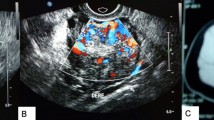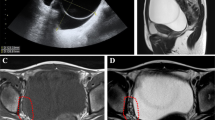Abstract
Purpose
To describe the presentation and fertility sparing treatment of a young woman found to have a steroid cell tumor not otherwise specified (NOS) and her spontaneous pregnancy and delivery shortly after surgery.
Methods
A 20-year-old Hispanic female presented with hirsuitism, virilization, and elevated androgen levels (testosterone 328 ng/dL) and was wrongly diagnosed with polycystic ovarian syndrome. Four months later she sought a second opinion. Her androgens were as follows: testosterone level 485 ng/dL, androstenedione 1,738 ng/dL and DHEA 1,459 ng/dL. She had normal levels of progesterone, estradiol, and DHEA-SO4. On transvaginal ultrasound she had a solid-appearing right ovarian mass. She underwent fertility sparing surgery with a laparoscopic right oophorectomy.
Results
Gross and histological pathology confirmed a benign steroid cell tumor NOS. She had rapid normalization of all androgens 13 days after surgery. She had spontaneous resumption of menses 4 months later. She conceived despite using emergency contraception approximately 9 months following surgery and delivered a healthy boy at term without complication.
Conclusion
Prompt evaluation for an androgen producing tumor should be performed when testosterone levels are greater than 200 ng/dL. Pregnancy following removal of this rare tumor has not previously been reported.



Similar content being viewed by others
References
ACOG Practice Bulletin No. 108: polycystic ovary syndrome. Obstet Gynecol. 2009;114:936–49.
Deavers MT, Malpica A, Ordonez NG, Silva EG. Ovarian steroid cell tumors: an immunohistochemical study including a comparison of calretinin with inhibin. Int J Gynecol Pathol. 2003;22:162–7.
Elhadd TA, Connolly V, Cruickshank D, Kelly WF. An ovarian lipid cell tumour causing virilization and Cushing’s syndrome. Clin Endocrinol. 1996;44:723–5.
Hayes MC, Scully RE. Ovarian steroid cell tumors (not otherwise specified). A clinicopathological analysis of 63 cases. Am J Surg Pathol. 1987;11:835–45.
Kommoss F, Oliva E, Bhan AK, Young RH, Scully RE. Inhibin expression in ovarian tumors and tumor-like lesions: an immunohistochemical study. Mod Pathol. 1998;11:656–66.
Meldrum DR, Abraham GE. Peripheral and ovarian venous concentrations of various steroid hormones in virilizing ovarian tumors. Obstet Gynecol. 1979;53:36–43.
Powell JL, Dulaney DP, Shiro BC. Androgen-secreting steroid cell tumor of the ovary. South Med J. 2000;93:1201–4.
Reedy MB, Richards WE, Ueland F, Uy K, Lee EY, Bryant C, et al. Ovarian steroid cell tumors, not otherwise specified: a case report and literature review. Gynecol Oncol. 1999;75:293–7.
Scully RE, Young RH, Clement PB. Steroid cell tumors. In: Tumors of the ovary, maldeveloped gonads, fallopian tube, and broad ligament: Afip atlas of tumor pathology No. 23, 1st edn. American RRRegistry of Pathology; 1996. pp 227–38.
Stephen MR, Lindop GB. A renin secreting ovarian steroid cell tumour associated with secondary polycythaemia. J Clin Pathol. 1998;51:75–7.
Young R, Scully R. Steroid cell tumors of the ovary. In: Fox H (ed) Haines and Taylor obstetrical and gynecological pathology, 3rd edn. Churchill Livingstone; 2003. pp. 845–56.
Author information
Authors and Affiliations
Corresponding author
Additional information
Capsule Testosterone levels above 150–200 ng/dL should raise suspicion for malignancy. Following laparoscopic right oopherectomy for a steroid cell tumor NOS, this patient had quick resumption of menses, conceived nine months following surgery, and delivered without complication.
Rights and permissions
About this article
Cite this article
Sielert, L., Liu, C., Nagarathinam, R. et al. Androgen-producing steroid cell ovarian tumor in a young woman and subsequent spontaneous pregnancy. J Assist Reprod Genet 30, 1157–1160 (2013). https://doi.org/10.1007/s10815-013-0051-9
Received:
Accepted:
Published:
Issue Date:
DOI: https://doi.org/10.1007/s10815-013-0051-9




